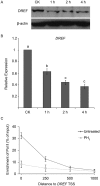Phosphine inhibits transcription of the catalase gene through the DRE/DREF system in Drosophila melanogaster
- PMID: 29018235
- PMCID: PMC5635064
- DOI: 10.1038/s41598-017-13439-4
Phosphine inhibits transcription of the catalase gene through the DRE/DREF system in Drosophila melanogaster
Abstract
Phosphine (PH3) is a toxin commonly used for pest control. Its toxicity is attributed primarily to its ability to induce oxidative damage. Our previous work showed that phosphine could disrupt the cell antioxidant defence system by inhibiting expression of the catalase gene in Drosophila melanogaster (DmCAT). However, the exact mechanism of this inhibition remains unclear. Here, we implemented a luciferase reporter assay driven by the DmCAT promoter in D. melanogaster S2 cells and showed that this reporter could be inhibited by phosphine treatment. A minimal fragment of the promoter (-94 to 0 bp), which contained a DNA replication-related element (DRE) consensus motif (-78 to -85 bp), was sufficient for phosphine-mediated reporter inhibition, suggesting the involvement of the transcription factor DREF. Furthermore, phosphine treatment led to a reduction in DREF expression and consequent repression of DmCAT transcription. Our results provide new insights on the molecular mechanism of phosphine-mediated catalase inhibition. Phosphine treatment leads to reduced levels of the transcription factor DREF, a positive regulator of the DmCAT gene, thereby resulting in the repression of DmCAT at transcriptional level.
Conflict of interest statement
The authors declare that they have no competing interests.
Figures





Similar articles
-
Transcriptional inhibition of the Catalase gene in phosphine-induced oxidative stress in Drosophila melanogaster.Pestic Biochem Physiol. 2015 Oct;124:1-7. doi: 10.1016/j.pestbp.2015.05.005. Epub 2015 May 11. Pestic Biochem Physiol. 2015. PMID: 26453223
-
The Drosophila histone methyltransferase NSD is positively regulated by the DRE/DREF system.Genes Genomics. 2018 May;40(5):475-484. doi: 10.1007/s13258-018-0649-5. Epub 2018 Feb 1. Genes Genomics. 2018. PMID: 29892958
-
Role of DREF in transcriptional regulation of the Drosophila p53 gene.Oncogene. 2010 Apr 8;29(14):2060-9. doi: 10.1038/onc.2009.483. Epub 2010 Jan 18. Oncogene. 2010. PMID: 20101238
-
The DRE/DREF transcriptional regulatory system: a master key for cell proliferation.Biochim Biophys Acta. 2008 Feb;1779(2):81-9. doi: 10.1016/j.bbagrm.2007.11.011. Epub 2007 Dec 4. Biochim Biophys Acta. 2008. PMID: 18155677 Review.
-
DREF plays multiple roles during Drosophila development.Biochim Biophys Acta Gene Regul Mech. 2017 Jun;1860(6):705-712. doi: 10.1016/j.bbagrm.2017.03.004. Epub 2017 Mar 28. Biochim Biophys Acta Gene Regul Mech. 2017. PMID: 28363744 Review.
References
-
- Bell CH. Fumigation in the 21st century. Crop Prot. 2000;19:563–569. doi: 10.1016/S0261-2194(00)00073-9. - DOI
-
- Pimentel MAG, Faroni LRDA, Guedes RNC, Sousa AH, Tótola MR. Phosphine resistance in Brazilian populations of Sitophilus zeamais Motschulsky (Coleoptera: Curculionidae) J. Stored Prod. Res. 2009;45:71–74. doi: 10.1016/j.jspr.2008.09.001. - DOI
Publication types
MeSH terms
Substances
LinkOut - more resources
Full Text Sources
Other Literature Sources
Molecular Biology Databases

